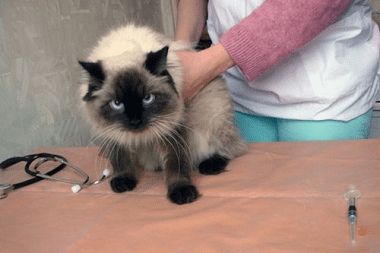Diseases of pets >>>> Pet and medications
Pet and medications.

Self-medication is also dangerous in the case of animal medication. If you are not a doctor, not a pharmacist, then you do not understand the dosage of medications, and it is very dangerous to give a medication that is suitable for your opinion to an animal on your own.
It's all about the dosages of the drug, which are calculated based on the weight of a sick person or animal. Low weight animals should receive medication according to their statistical weight. It is possible to draw an analogy with drugs for children, when the dose of the drug for children can be underestimated or differentiated depending on the age of the child. But what to do in cases when the animal needs emergency help, it is far from the nearest health worker and veterinarian, and death may be inevitable? The scales and instructions for the preparation that you have at your disposal will help you.
How do you compare your pet's weight and your medication? We weigh the animal (cat or dog), write down the weight, read the section "Taking the medicine by children" in the instructions, figure out in what proportion the children's dose of the medicine is calculated in relation to an adult. We find out in this way the approximate weight for the child. We correlate the weight of the child with the weight of the animal and make the appropriate proportion in the dosage of the drug.
For example, for a therapeutic effect, a drug is taken by an adult on a tablet three times a day (per day). Let's say the child's dose is half a tablet according to the instructions. The weight of an adult (from 143 to 176 pounds, on average = 159 pounds), the child's weight will be half as much (average) - divide the child's dose in proportion to the child's weight to get a part of the tablet per 2,2 pounds of weight, multiply this part by the weight your animal and get the approximate dosage of the drug. If the instructions indicate a dosage for an infant, it can also be used for a medium-sized animal.
But do not forget that some drugs used for adults are contraindicated for children, and many drugs for humans are contraindicated for animals, since animals have their own specific structure of the digestive system, enzymatic activity and excretion of drug residues from the body. Experiments can only be carried out if there is a choice between the life and death of the pet. In other cases, it is necessary to consult a veterinarian and his recommendations on the selection of medicines.
Sometimes medical assistance is required for an animal due to injury (trauma), and in such cases, medications for disinfecting the site of injury, the application of medicinal ointments is quite acceptable with the use of medicines intended for humans.
There are problems in the adoption of medicines by animals, because for them this process is unconscious. In such cases, there are several ways to force the animal to take a drug: hide it in a food product, spread it with a tasty product, for example, a pate. You can adapt and put the pill directly into the mouth of the animal, while controlling the swallowing process so that the animal does not choke. The hardest part is getting the animal to drink liquid medications. In such cases, liquid is manually poured into the cheek pouch (between the cheek and teeth) using a pipette, a bottle with a nipple, a syringe without a needle, a small syringe, and the swallowing reflex is controlled.
When giving medications to an animal on its own, you should always take into account the likelihood of developing a side effect in the form of an allergic reaction or anaphylactic shock. Such cases require immediate injections of epinephrine and antihistamines, which can be a problem at home. For this reason, if you are not confident in the health of the animal and in your skills in providing resuscitation measures, carry out complex medicinal infusions in veterinarians' offices, where anti-shock and anti-allergic drugs are always at hand.

Read

Read



























